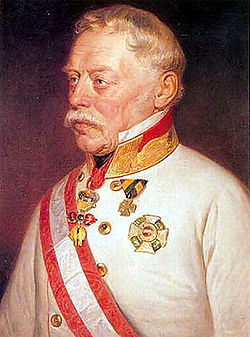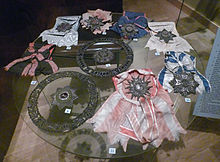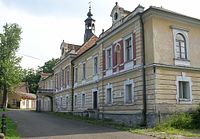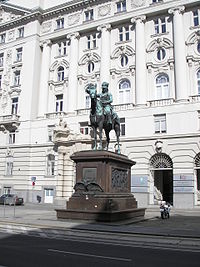- Joseph Radetzky von Radetz
-
"Radetzky" redirects here. For other uses, see Radetzky (disambiguation).
Joseph Radetzky von Radetz 
Josef Graf Radetzky von RadetzBorn November 2, 1766
Třebnice, BohemiaDied January 5, 1858 (aged 91)
Milan, ItalyAllegiance Habsburg Empire Years of service 1785 – 1858 Rank Field Marshal Johann Josef (Joseph) Wenzel (Anton Franz Karl) Graf Radetzky von Radetz (English: John Joseph Wenceslaus, Count Radetzky of Radetz, Czech: Jan Josef Václav hrabě Radecký z Radče) (November 2, 1766 – January 5, 1858) was a Czech nobleman[1] and Austrian general, immortalised by Johann Strauss I's Radetzky March. General Radetzky was in the military for over 70 years, until his death at age 91, and is known for the victories at the Battles of Custoza (July 24–25, 1848) and Novara (March 23, 1849) during the First Italian War of Independence.
Contents
Early years
Radetzky was born into a noble family at Chateau (zámek) Třebnice (German: Trebnitz) near Sedlčany in Bohemia (now part of the town). Orphaned at an early age, he was educated by his grandfather, and after the count's death, at the Theresa Academy at Vienna. The academy was dissolved during his first year's residence in 1785, and Radetzky became a cadet in the Austrian Army. The following year he became an officer, and in 1787 was promoted to first lieutenant in a cuirassier regiment. He served as a galloper on Count von Lacy's staff in the Turkish War, and in the Austrian Netherlands from 1792 to 1795.
In 1798 he married Countess Francisca von Strassoldo Grafenberg, from Tržič, Carniola (now in Slovenia). They would have five sons and three daughters.
Napoleonic wars
In 1795 Radetzky fought on the Rhine. The following year he served with Johann Beaulieu against Napoleon in Italy, but disliked the indecisive "cordon" system of warfare which Count von Lacy had instituted and other Austrian generals imitated. His personal courage was conspicuous. At the Battle of Fleurus (1794) he led a party of cavalry through the French lines to discover the fate of Charleroi, and at Valeggio sul Mincio in 1796, with a few hussars, he rescued Beaulieu from the enemy. Promoted to major, he took part in Dagobert Wurmser's Siege of Mantua campaign, which ended in the fall of that fortress. As lieutenant-colonel and colonel he displayed bravery and skill in the battles of Trebbia and Novi (1799). At the Battle of Marengo, as colonel on the staff of Melas, he was hit by five bullets, after endeavouring on the previous evening to bring about modifications in the plan suggested by the "scientific" Franz Zach. In 1801 Radetzky was created a Knight of the Military Order of Maria Theresa.
In 1805, on the march to Ulm, he received news of his promotion to major-general and his assignment to a command in Italy under the Archduke Charles of Austria. He thus took part in the failed campaign of Caldiero. Peace provided a short respite, which he spent in studying and teaching the art of war. In 1809 he led a brigade in V Corps during the Battle of Eckmuhl.[2] Promoted lieutenant field marshal, he commanded a division in IV Corps at the Battle of Wagram.[3] In 1810 he was created a Commander of the Order of Maria Theresa and awarded the colonelcy of the 5th Radetzky Hussars. From 1809 to 1812, as chief of the general staff, he was active in reorganising the army and its tactical system, but, unable to carry out the reforms he desired owing to the opposition of the Treasury, he resigned his position. In 1813 he was Schwarzenberg's chief of staff and had considerable influence on the councils of the Allied sovereigns and generals. Langenau, the quartermaster-general of the Grand Army, found him an indispensable assistant, and he had a considerable share in planning the Leipzig campaign.He won praise for his tactical skills in the battles of Brienne and Arcis sur Aube. He entered Paris with the allied sovereigns in March 1814, and returned with them to the Congress of Vienna, where he appears to have acted as an intermediary between Metternich and Tsar Alexander I of Russia, when the two were not on speaking terms.
Italian campaigns
 Former Radetzky Memorial in Malostranské náměstí, Prague, removed in 1919, now on display in collections of National Museum
Former Radetzky Memorial in Malostranské náměstí, Prague, removed in 1919, now on display in collections of National Museum
During the succeeding years of peace he disappeared from public view. He resumed his functions as chief of staff, but his ardent ideas for reforming the army came to nothing in the face of the general war-weariness and desire to "let well alone." His zeal added to the number of his enemies, and in 1829, after twenty years as lieutenant field marshal, it was proposed to place him on the retired list. The emperor, unwilling to go so far as this, promoted him general of cavalry and shelved him by making him governor of a fortress. But very soon afterwards the Restoration settlement of Europe was shaken by fresh upheavals, and Radetzky was brought back into the field of war again. He took part under Frimont in the campaign against the Papal States insurgents, and succeeded that general in the chief command of the Austrian army in Italy in 1834.
In 1836 he became a field marshal. He was now seventy, but still displayed the activity of his youth in the training and discipline of the army he commanded. But here too he was in advance of his time, and the government not only disregarded his suggestions and warnings but also refused the miltary the money that would have enabled the finest army it possessed to take the field at a moment's notice. Thus the events of 1848 in Italy, which gave the old field marshal his place in history among the great commanders, found him, in the beginning, not indeed unprepared but seriously handicapped in the struggle with Charles Albert's army and the insurgents in Milan and elsewhere. By falling back to the Quadrilateral and there,rebuffing one opponent after another, he was able to spin out time until reinforcements arrived, and thenceforward up to the final triumph at the Battle of Novara on March 23, 1849, he and his army carried all before them. He also commanded the Austrian troops who reconquered Venice after the year-long siege of the rebellious city in May 1848-August 1849. He became a Knight of the Order of the Golden Fleece in 1848.
His well-disciplined sense of duty towards officers of higher rank had become more intense in the long years of peace, and, after keeping his army loyal midst the confusion of 1848, he made no attempt to play the part of Wallenstein or even to assume Wellington's role of 'family adviser to the nation'. While as a patriot he dreamed a little of a united Germany, he remained to the end simply the commander of one of the emperor's armies.
After his triumph in Italy, he was made Viceroy of Lombardy-Venetia from 1848 to 1857 - being the only one not of royal Habsburg blood. In spite of his success against Italian patriots, even in Italy he is not remembered unkindly : he was regarded as a fair ruler (for an enemy) and a gentleman who paid his debts. There is also a memorable anecdote of his meeting the man responsible for one of the most significant checks in the 1848 campaign, General Cesare Launier, shaking his hand, and congratulating him on getting "a bunch of kids" (much of Launier's command was made up of volunteer university students) to fight so hard that Radetzky and his men seriously thought they were facing crack professional Sardinian troops. Politically, he worked to reconcile the lower classes especially, to the Habsburg monarchy; he could see the Industrial Revolution coming and hoped to use the conflict of classes to isolate the patriotic party, made up mostly of the upper and middle classes, from the rising working class. He was ruthless in punishing rebellious soldiers - Hungarian troopers who had passed to the rebels' side in 1848 were not even shot, but hanged - and violent rebels, but very mild with unarmed opponents: patriot leaders of European renown, such as Giuseppe Verdi, Alessandro Manzoni and Antonio Rosmini, were allowed to live in peace in the kingdom, while Italy's other reactionary governments drove all their liberals into exile. Already in 1849, at the end of the siege of Venice, he had allowed the local patriot leaders to quietly slip away, and avoid public martyrdom. This was probably the best policy that Austria could possibly adopt in the circumstances, but it was doomed anyway; the events of 1848-49 had dug too deep a chasm between the Italians and the Austrian government, and - as events in 1859 showed - it was only the power of Austrian military might that kept Austria and her client states in Italy. It was part of Radetzky's good fortune that he died one year before his whole work dissolved like ice in an erupting volcano.
Death
He died in harness, though in poor health. Josef Wenzel Graf Radetzky of Radetz died on January 5, 1858 after an accident in Milan. On January 19, 1858, he was buried in Heldenberg in Lower Austria. The Emperor wished that he be buried in the Capuchin crypt (the Imperial Crypt in Vienna). Radetzky bequeathed his earthly remains, and the right to bury him, to Joseph Gottfried Pargfrieder, who decades earlier had settled his debts. In Heldenberg is an open-air pantheon with warrior statues, the Gedenkstätte Heldenberg (literally translated as the Hero Mountain Memorial.) Radetzky lies buried under a monumental obelisk.
Ancestry
Ancestors of Joseph Radetzky von Radetz [4] 16. Baron Jan Jiří Radecký z Radče 8. Baron Petr Eusebius Viktorin Radecký z Radče 17. Albertina Eusebie von Briaumont 4. Count Václav Leopold Radecký z Radče 18. Julius Weikhart von Heussenstamm 9. Marie Polyxena von Heusenstamm 19. Johana Isabela Veronika Ogilvy 2. Count Peter Eusebius Radetzky von Radetz 20. 10. František Mikuláš Bzenský z Prorubě 21. 5. Anna Bzenská z Prorubě 22. Jindřich Jan Straka z Nedabylic 11. Anna Marie Straková z Nedabylic 23. Marie Veronika Stošová z Kounic 1. Count Joseph Radetzky von Radetz 24. Baron Mikuláš Felix Bechinie z Lažan 12. Baron František Leopold Bechinie z Lažan 25. Alžběta Věžníková z Věžník 6. Baron Ignác Ladislav Bechinie z Lažan 26. 13. Marie Magdalena Sohier von der Windmühl 27. 3. Baroness Marie Venantia Bechinie von Lažan 28. Count Bernard František Ignác Věžník z Věžník 14. Count Leopold Ignác Věžník z Věžník 29. Terezie Rosina von Arco 7. Countess Marie Františka Věžníková z Věžník 30. Leopold Vilém I. z Valdštejna 15. Marie Alžběta z Valdštejna 31. Marie Elisabeth Khuen von Belasi Legacy
In military history Radetzky's fame rests on one great achievement, but in the history of the Austrian army he figures as the frank and kindly "Vater Radetzky" whom the soldiers idolized. In the year following his death, another and greater Italian war broke out, and his beloved army disintegrated and was defeated in every encounter.
References
 Chisholm, Hugh, ed (1911). "Radetzky, Josef". Encyclopædia Britannica (11th ed.). Cambridge University Press.
Chisholm, Hugh, ed (1911). "Radetzky, Josef". Encyclopædia Britannica (11th ed.). Cambridge University Press.
- ^ RADECKÝ z RADČE Jan Josef Václav hrabě
- ^ Bowden, p 70
- ^ Bowden, p 164
- ^ http://patricus.info/Panstvo.htm
Notes
Regarding personal names: Graf is a title, translated as Count, not a first or middle name. The female form is Gräfin.
Further reading
 Some of the about 40 decorations of Radetzky on display at the Heeresgeschichtliches Museum Vienna.
Some of the about 40 decorations of Radetzky on display at the Heeresgeschichtliches Museum Vienna.
Radetzky in history
- Alan Sked: The survival of the Habsburg Empire: Radetzky, the Imperial Army, and the Class War, 1848. London; New York: Longman, 1979, ISBN 0-582-50711-1
- Alan Sked: Radetzky: Imperial Victor and Military Genius. London; New York: I.B. Tauris, 2011, ISBN 978-1-84885-677-6
- Oskar Regele: Feldmarschall Radetzky: Leben, Leistung, Erbe. Wien: Herald, [1957]
Works by Radetzky
- Joseph Radetzky von Radetz: Denkschriften militärisch-politischen Inhalts aus dem handschriftlichen Nachlass des k.k. österreichischen Feldmarschalls Grafen Radetzky. Stuttgart: J.G. Cotta, 1858
Correspondence
- Joseph Radetzky von Radetz: Briefe des Feldmarschalls Radetzky an seine Tochter Friederike 1847-1857; aus dem Archiv der freiherrlichen Familie Walterskirchen hrsg. von Bernhard Duhr: Festschrift der Leo-Gesellschaft zur feierlichen Enthüllung des Radetzsky-Denkmals in Wien. Wien: J. Roller, 1892.
These are Radetzky's letters to his daughter Friederike Radetzky von Radetz, Gräfin Wenckheim, published to celebrate the unveiling of the Radetzky monument in Vienna.
Biographies
- Franz Herre: Radetzky: eine Biographie. Köln: Kiepenheuer & Witsch, c1981. ISBN 3-462-01486-2
- Franz Ferdinand Hoettinger: Radetzky: ein Stück Österreich. Leipzig; Wien: Höger, 1934.
- Joseph Radetzky von Radetz: Radetzky: sein Leben und sein Wirken; nach Briefen, Berichten und autobiographischen Skizzen zusammengestellt von Ernst Molden. Leipzig: Insel-Verlag, [1915] (Österreichische Bibliothek; Nr. 10)
- Alessandro Luzio: Radetzky. Bergamo: Istituto italiano d'arti grafiche, 1901
- Alan Sked: Radetzky: Imperial Victor and Military Genius. I.B.Tauris, 2011. ISBN 978-1-84885-677-6
Military career
- Petr Havel and Andrej Romanák: Maršál Radecký: vojevůdce pěti císařů. Praha: Paseka, 2000. ISBN 80-7185-297-X
- Viktor Bibl: Radetzky: Soldat und Feldherr. Wien: J. Günther, [c1955]
- Hugo Kerchnawe: Radetzky: eine militär-biographische Studie. Prag: Volk und Reich Verlag, [1944]
- Oskar Freiherr Wolf-Schneider von Arno: Der Feldherr Radetzky. [Wien: Verlag der Militärwissenschaftlichen Mitteilungen, 1934] (Reprinted from the second ed. of 'Militärwissenschaftliche Mitteilungen', No. 3)
- Hermann Kunz: Die Feldzüge des Feldmarschalls Radetzky in Oberitalien 1848 und 1849. Berlin: R. Wilhelmi, 1890
- A. B. Gavenda and Franz de Vuko et Branko (eds.): Feldmarschall Graf Radetzky, sein Leben und seine Taten. Prag: Rohlicek, 1858
- Franz Schneidawind: Feldmarschall Graf Radetzky: sein kriegerisches Leben und seine Feldzüge vom Jahre 1784-1850. Augsburg: Schmid, 1851
- Johann Sporschil: Der Feldzug der Oesterreicher in der Lombardei unter dem General-Feldmarschall Grafen Radetzky in den Jahren 1848 und 1849. 2. Ausg. Stuttgart: Köhler, 1850
- P. S. Lebedev: Graf Radetskii i ego pokhody v Italii. [n.p.], 1850.
- Bowden, Scotty & Tarbox, Charlie. Armies on the Danube 1809. Arlington, Texas: Empire Games Press, 1980.
Anecdotal Histories
- [Anni Stern-Braunberg]: In deinem Lager ist Österreich!: Geschichte und Anekdoten um Feldmarschall Radetzky. Graz: Stocker, 2000, ISBN 3-7020-0898-5
- Otto Stradal: Der andere Radetzky: Tatsachen und Gedanken um ein Phänomen. Wien: Österreichischer Bundesverlag, c1981, ISBN 3-215-04438-2
- Franz Grobauer (ed.): In seinem Lager war Österreich: Feldmarschall Radetzky in Geschichte und Anekdote. [Wien], 1957
Radetzky in drama and music
- Alexander Lernet-Holenia: Radetzky: Schauspiel in drei Akten. [Frankfurt am Main]: S. Fischer, 1956.
- Johann Strauss: Radetzky March (Opus 228)
- Vater Radetzky, a 1929 film biopic
External links
 Media related to Count Johann Joseph Wenzel Radetzky von Radetz at Wikimedia CommonsCategories:
Media related to Count Johann Joseph Wenzel Radetzky von Radetz at Wikimedia CommonsCategories:- 1766 births
- 1858 deaths
- People from Sedlčany
- Austrian Field Marshals
- 18th-century Czech people
- 19th-century Czech people
- 18th-century Austrian people
- 19th-century Austrian people
- Austro-Hungarian people
- Czech Austro-Hungarians
- Austrian generals
- Austrian soldiers
- Czech military personnel
- Czech generals
- People of the Revolutions of 1848
- Austrian Empire military leaders of the French Revolutionary Wars
- Austrian Empire commanders of the Napoleonic Wars
- Knights of the Golden Fleece
- Knights Grand Cross of the Order of Saint Ferdinand and of Merit
- Recipients of the Order of Saint George I Class
- Recipients of the Order of Saint George III Class
- Knights Grand Cross of the Military Order of Maria Theresa
- Knights Grand Cross of the Order of Saint Joseph
- Knights of the Order of Saint Hubert
- Bohemian nobility
- Austrian nobility
- Austrian people of Czech descent
- Knights Grand Cross of the Order of the Zähringer Lion
- Austrian military personnel of the Italian Independence Wars
Wikimedia Foundation. 2010.



